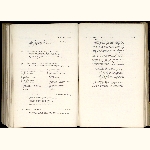Details of exhibit
- Exhibition:
- 1904 Forty-ninth Annual Exhibition of the Royal Photographic Society of Great Britain
- Exhibit title:
- Studies in the Biology of Flowers
- Exhibitor:
- B. H. Bentley
- Section:
- Lantern Slides
- Exhibit No.:
- 700
- Description:
- Wild Arum plant with inflorescence.
Section of Arum inflorescence before bursting of stamens, showing the hairs which imprison the insects.
Section of Arum inflorescence after bursting of stamens. The insects has been dusted with pollen, and the hairs have withered and set them free.
Male Willow Catkins. Differ from most male catkins in being attractive to insects by honey and the bright colour of the pollen; are further peculiar in being rigid and not pendulous.
Foxglove: sections of flower. A typical bumble bee flower. The insect's body exactly fits the tubular flower, and pollen is dusted on its back when the flower is in stage 1 (upper); when the flower is in stage 2 (lower), the stigma touches the bee's back and picks up the pollen. The spots on the corolla are honey guides for the insect.
Flower of White Cactus. Type of flower with a spirally arranged perianth.
Florets dissected from a Sunflower inflorescence showing: -
1. Sterile showy floret.
2. Seven stages of a fertile floret:
(a) closed; (b) the staminal tube; (c) the style carrying the pollen out of the staminal tube; the floret is now in the male stage; (d e f) the style branches separating and exposing the stigmas as the floret passes over to the female stage; (g) the stigmas reflexed for picking up pollen from the same floret when cross pollination has failed.
Bee Orchis Inflorescence.
Flower of Bee Orchis. Shows the candicles of the two pollina which are still in the anther.
Flower of Bee Orchis. The pollina have fallen from the anthers and are ready to touch the stigmas. - Exhibit type:
- Photograph
- Process:
- [Not Listed] ()
- Award:
- none

